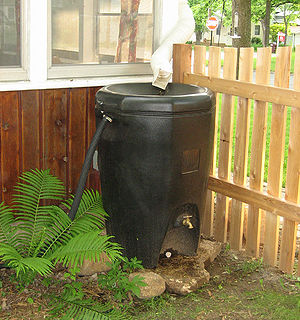
Stormwater re-use and rainwater harvesting
Contents
Rainwater Harvesting
Rain water harvesting is the practice of collecting rain water from impermeable surfaces, such as rooftops, and storing for future use. There are a number of systems used for the collection, storage and distribution of rain water including rain barrels, cisterns, evaporative control systems, and irrigation.
Design Criteria
- The system should be watertight, have a smooth interior surface, be located on level and stable ground, have a tight-fitting lid, good screens on the inlet and outlet and have an emergency overflow device.
- To prevent the breeding of mosquitoes, empty the water in less than 5 days or place a fine screen over all openings.
- Material can withstand the pressure of water over long periods of time.
- Disconnect and drain rain barrels and cisterns in the winter to prevent freezing and deformation of the rain water harvesting system.
MANAGEMENT SUITABILITY
- Water Quality (Vwq) - High1
- Channel Protection (Vcp) - Med.
- Overbank Flood Protection (Vp10) - Low
- Extreme Flood Protection (Vp100) - Low
(Recharge Volume (Vre) - High1
MECHANISMS
- Infiltration1
- Screening/ Filtration1
- Temperature Control
- Settling
- Evaporation
- Transpiration1
- Soil Adsorption1
- Biological/ Micro. Uptake1
POLLUTION REMOVAL
- Total Suspended Solids - 100%1
- Nutrients - Total Phosphorus/Total Nitrogen- 100%1
- Metals - Cadmium, Copper, Lead, and Zinc- 100%1
- Pathogens - Coliform, Streptococci, E. Coli- 100%1
- Toxins - Hydrocarbons, Pesticides- 100%1
SITE FACTORS
- Drainage Area - Rooftop
- Max. Slope - NA
- Min. Depth to Bedrock - NA
- Min. Depth to Water Table - NA
- SCS Soil Type - can be used in C&D soil types with modifications (e.g. underdrains) - NA
- Poor Freeze/ Thaw Suitability - NA
- Potential Hotspot Runoff - Suitable
1Assuming water is drained to a vegetated pervious area. Does not apply to volume of runoff that bypasses the system
Benefits
- Protects water supplies by reducing use during peak summer months.
- Mimics the natural hydrology of the area by infiltrating a portion of the rain water falling on the site.
- Reduces volume of storm water being delivered to downstream waterbodies.
- Results in cost savings by reducing municipal water bill.
Limitations
- Not suitable for the following roof types: tar and gravel, asbestos shingle and treated cedar shakes.
- Depending on the design, requires a certain amount of operation and maintenance.
- Proprietary systems can be expensive.
Description
Rain water harvesting can be accomplished using rain barrels and/or cisterns. Rain barrels are typically located at the downspout of a gutter system and are used to collect and store rainwater for watering landscapes and gardens.
The simplest method of delivering water is by the force of gravity. However, more complex systems can be designed to deliver the water from multiple barrels connected in a series with pumps and flow control devices.
Cisterns have a greater storage capacity than rain barrels and may be located above or below ground. Due to their size and storage capacity, these systems are typically used to irrigate landscapes and gardens on a regular basis reducing the strain on municipal water supplies during peak summer months. Again, cisterns may be used in series and water is typically delivered using a pump system.
The storage capacity of a rain barrel or cistern is a function of the catchment area, the depth of rainfall required to fill the system and the water losses. A general rule of thumb in sizing rain barrels or cisterns is that one inch of rainfall on a 1,000 square foot roof will yield approximately 600 gallons of runoff.
